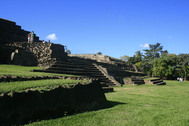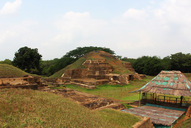Joya de CerenThis special site was a pre-Hispanic farming community, very similar than Pompeii and in the old Italy, was buried under the eruption vocanoe know as "Caldera" around AD 600. This unique condition of the remains, they provide an insight into the daily lives of the Central American population that work in agriculture in that time.
The site was discovered in 1976 by a bulldozer driver leveling ground for a government agricultural project. It was explored byPayson Sheets, from the University of Colorado at Boulder, in 1978 and 1980. Excavation resumed in 1988, and has been continuous since then. About 70 buildings have been uncovered, including storehouses, kitchens, living quarters, workshops, a religious structure, and what is known as Temazcal what it was a communal spiritual sauna. |
|
About Joya de Ceran and its History:.
Joya de Ceren research work discover this small farming community inhabited as early as 1200 BC, Cerén was on the southeast edge of the Maya cultural area right in the center of El Salvador country. It was evacuated around AD 200 because of the eruption of the Ilopango volcanoe, and was repopulated before AD 400. when was the time of its final evacuation.
Around the year 590 another volcano, known as Loma Caldera, erupted and buried the village under several layers of ash. The villagers were apparently able to flee in time because no bodies have been found in the site – although they left behind ceramics, utensils, furniture, and food in their time that they escape. The site was well preserved due to the temperature of ash. This is what makes this site unique and special, the volcanic eruption was so sudden that artefacts representative of every aspect of daily life were found still in place around the buildings, while perishable materials, including plants, survive either as carbonized material or as casts in the ash deposit. The objects recovered by excavation from the buildings constitute a virtual inventory of their contents at the moment of eruption.
Several cultivated fields and other vegetation have also been uncovered. These include fields containing young and mature maize plants, a kitchen garden with a variety of herbs and a henequen (agave) garden. Various fruit trees, including guayaba and cacao, have also been found.
The site was discovered during the construction of government grain-storage silos in 1976, when a clay-built structure was exposed by a bulldozer. Excavation were carried out under the direction of Dr Payson D. Sheets (University of Colorado) in 1978 and 1980, but were interrupted by civil war. They were resumed in 1988 and have been continuing since that time.
Twelve structures were excavated, including living quarters, storehouses, workshops, kitchens, a communal sauna and a religious structure. Cerén is thought to have been home to about 200 people, although no human remains have been found. The buildings are grouped into compounds that include structures for sleeping, storage, cooking and handicrafts. The specialized structures include a sweat house, a large communal building, and two which may have been used by specialists such as a shaman or a healer.
Around the year 590 another volcano, known as Loma Caldera, erupted and buried the village under several layers of ash. The villagers were apparently able to flee in time because no bodies have been found in the site – although they left behind ceramics, utensils, furniture, and food in their time that they escape. The site was well preserved due to the temperature of ash. This is what makes this site unique and special, the volcanic eruption was so sudden that artefacts representative of every aspect of daily life were found still in place around the buildings, while perishable materials, including plants, survive either as carbonized material or as casts in the ash deposit. The objects recovered by excavation from the buildings constitute a virtual inventory of their contents at the moment of eruption.
Several cultivated fields and other vegetation have also been uncovered. These include fields containing young and mature maize plants, a kitchen garden with a variety of herbs and a henequen (agave) garden. Various fruit trees, including guayaba and cacao, have also been found.
The site was discovered during the construction of government grain-storage silos in 1976, when a clay-built structure was exposed by a bulldozer. Excavation were carried out under the direction of Dr Payson D. Sheets (University of Colorado) in 1978 and 1980, but were interrupted by civil war. They were resumed in 1988 and have been continuing since that time.
Twelve structures were excavated, including living quarters, storehouses, workshops, kitchens, a communal sauna and a religious structure. Cerén is thought to have been home to about 200 people, although no human remains have been found. The buildings are grouped into compounds that include structures for sleeping, storage, cooking and handicrafts. The specialized structures include a sweat house, a large communal building, and two which may have been used by specialists such as a shaman or a healer.
Other important Mayan archaeology sites in El Salvador:.
Tazumal Ruins.
Tazumal is located in Chalchuapa town in Santa Ana department at the north side of the country, very close from Guatemala city, this site is where is located and discovered the bigger mayan temple in El Salvador read more Tazumal ruins
|
San Andres ruins.
San Andres is located at the Panamerican highway, this is a pre hispanic site that was developed 900 to 1200 AC, but was discovered until 1940 where it used to be a colonial farm.
|
Take a trip and Learn about the Salvadorean Mayan World.If you are interested to learn about archaeology and the Mayan World our tour operator partners develop a full day tour with special guide.
The tour start in Joya de Ceren site, San Andres and finally Tazumal Ruins, then the guide will drive you to the national Archaeology Museum "David J. Guzman" in located in the popular and touristic area of Zona Rosa in the Capital City San Salvador. This tour will take around 8 hours in total and the personal guide can pick you up from any hotel in San Salvador city or at any of the different beach hotels in La Libertad area. Rate will be according with the number of guest and from where the tour start. This trip is a great choice for a full day trip during your staying in El Salvador. |
|
Related Travel Links:.
Looking for travel information about El Salvador, find the best tips of what to do and where to go with the best Travel Guide in El Salvador list of destination and activities to do in this amazing travel destination in Central America.
Informacion turistica y arqueologica de El Salvador en la revista turistica en linea viajeros el salvador, vista este portal y encontraras fotografias y videos de los sitios arequeologicos como tazumal, joya de ceren y san andres en El Salvador, conoce el mundo maya viajero en el salvador
Looking for travel information about El Salvador, find the best tips of what to do and where to go with the best Travel Guide in El Salvador list of destination and activities to do in this amazing travel destination in Central America.
Informacion turistica y arqueologica de El Salvador en la revista turistica en linea viajeros el salvador, vista este portal y encontraras fotografias y videos de los sitios arequeologicos como tazumal, joya de ceren y san andres en El Salvador, conoce el mundo maya viajero en el salvador
